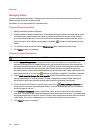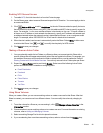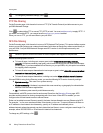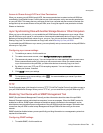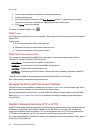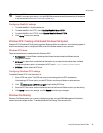
Access to Shares through NFS and User Permissions
When you access your px6-300d through NFS, the access permissions to content on the px6-300d are
controlled by Host-Based Access Control rules on your client computer, not by user access permissions
on your px6-300d. This means that any valid user on the Linux computer who has access to the host (the
storage device) can access Shares on the px6-300d, even if not given specific user permission to those
Shares on the device.
rsync: Synchronizing Files with Another Storage Device or Other Computers
When you turn on this protocol, you can enable the px6-300d Network Storage as an rsync server. When
the px6-300d is an rsync server, it can be used as a source and/or destination device for rsync Copy Jobs.
Because of the fast and efficient nature of rsync, an rsync Copy Job can be faster than a Windows File
Sharing Copy Job. For more information on Copy Jobs, refer to Backing Up Your px6-300d .
If you enable the px6-300d as an rsync server, you can optionally set up a user account on the px6-300d for
secure rsync Copy Jobs.
Configuring rsync server settings
1. To enable rsync server, click the switch on.
2. To create a secure user account, check Configure secure rsync credentials.
3. The username is preset as rsync. You can change this to a more meaningful user account name.
Enter a password and confirm it for the rsync user account name. When you create a secure
rsync user account on the px6-300d, you allow other devices to securely copy to or from it.
4. By default, rsync uses TCP port 873 for accepting requests. You can change this value to a
different port number, if desired.
5. Click Apply to save your settings.
To change any rsync server settings, click . You cannot enable rsync server if you have
already enabled SFTP.
TFTP
On the Protocols page, click the switch to turn on TFTP (Trivial File Transfer Protocol) and allow access to
your px6-300d Network Storage. When you turn TFTP on, you can send files to your px6-300d using FTP.
Monitoring Your Device with an SNMP Management Tool
SNMP (Simple Network Management Protocol) provides information about the state of the px6-300d
Network Storageto various administrative computers, known as managers. When the SNMP protocol is
enabled on a device, SNMP agent software on the device reports information to the managers, and an
administrator user can perform some configuration of the px6-300d through the manager. Information that
comes from the px6-300d is called a trap. Managers and the px6-300d must be running on the same
network.
SNMP should be disabled unless you are specifically providing information to a management system that
requires this information.
Configuring SNMP settings
1. To enable SNMP, click the switch on.
SharingFiles
Using Protocols to Share Files 30






